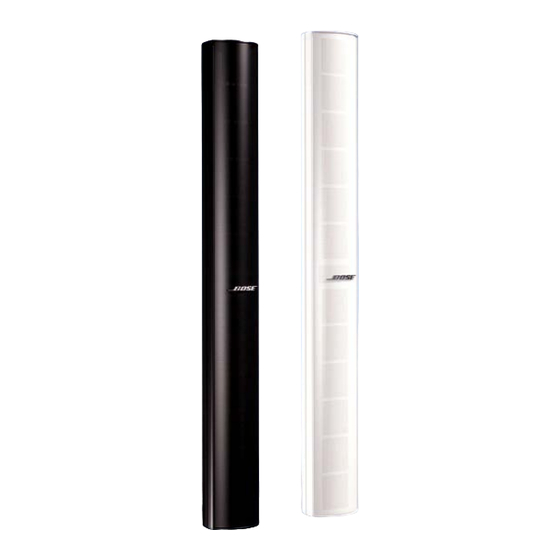Bose Panaray MA12 Teknik Temel ve Tartışma - Sayfa 18
Hoparlör Sistemi Bose Panaray MA12 için çevrimiçi göz atın veya pdf Teknik Temel ve Tartışma indirin. Bose Panaray MA12 36 sayfaları. Modular line array loudspeaker
Ayrıca Bose Panaray MA12 için: Kullanıcı Kılavuzu (2 sayfalar), Kurulum Kılavuzu (16 sayfalar), Kurulum Kılavuzu (8 sayfalar), Kurulum Kılavuzu (7 sayfalar), Servis Kılavuzu (11 sayfalar)

Figure 9. The radiation pattern of a long, thin source is wedge-shaped.
The sound radiates in two dimensions: in and out and left and right, but
not up and down.
How does sound intensity fall off as a function of distance for such sources and such
waves? The answer lies halfway between spherical waves and plane waves, as shown in
Figure 10. The spherical source radiates in three dimensions and falls off as 6 dB per
doubling of distance, the cylindrical wave radiates in two dimensions and falls off as 3 dB
per doubling of distance, and the plane wave radiates in one dimension and falls of as 0 dB
per doubling of distance.
2
For the reader interested in understanding the underlying physics of these differences, imagine a sound-
intensity-meter ten feet in front of a source producing each kind of wave: spherical, planar, and
cylindrical. Furthermore, imagine that at this distance, each source produces the same level. Now,
consider a small area of the sound wave at the location of the meter.
- As the spherical wave spreads out, the wave must expand over the surface of a sphere. When the sphere
doubles in diameter, the small area of the sound wave must expand over a proportionately larger area at
the doubled distance. As a result, the intensity of the original area of sound diminishes. Since the area of
a sphere increases as the square of the radius, increasing the distance from the source by a factor of two
(doubling the distance and therefore the radius) means reducing the sound intensity by a factor of four
(two squared). A factor of four in sound intensity corresponds to 6 dB.
- As the cylindrical wave spreads out, the wave must expand over the surface of a cylinder. When the
cylinder doubles in diameter, the small area of the sound wave at the closer distance must spread over a
proportionately larger area at the doubled distance. As a result the intensity of the original area of sound
wave is reduced. Since the area of a cylinder increases proportionately with only the radius (rather than
as the square of the radius as in the case of a sphere), increasing the distance from the source by a factor
of two (doubling the radius) means reducing the sound intensity by only a factor of two. A factor of two
in sound intensity corresponds to 3 dB.
- As the plane wave progresses, the wave does not expand. When the wave reaches a distance that is
double the original, the small area of the sound wave at the closer distance has not spread at all, and as a
result the intensity of the original piece of sound wave is the same. A factor of zero in sound intensity
corresponds to 0 dB.
®
Bose
MA12™ Modular Array: Technical Foundation & Discussion
April 2002, © Bose Corporation, All Rights Reserved
2
Page 18 of 36
